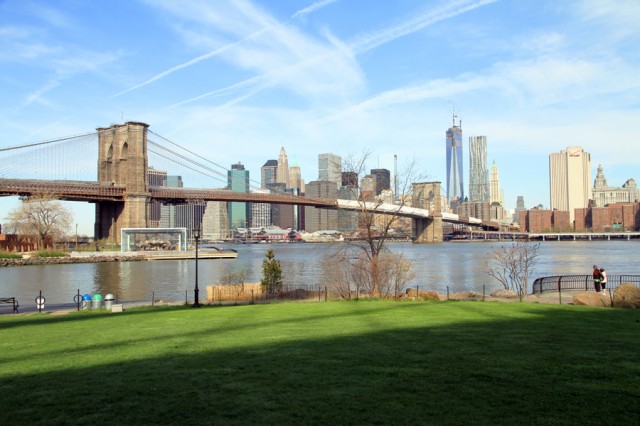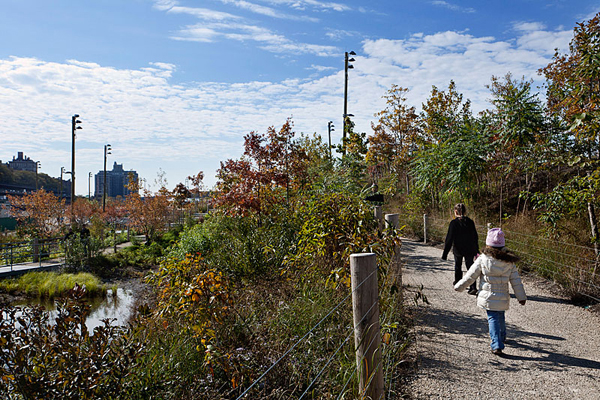
For most of New York’s existence, the city’s waterfront was a worksite; New York was long the busiest commercial port in the United States, and Manhattan, Brooklyn and Queens were studded with piers handling goods from all over the world. The Brooklyn waterfront in particular was also the site of more than a century of heavy industry, ranging from the massive Domino sugar factory in Williamsburg (for decades, the source of half the country’s sugar), to Standard Oil’s leaking refinery on Newtown Creek in Greenpoint, and to the enormous Brooklyn Navy Yard.
By the mid-1960s, container ships and cranes replaced longshoremen, and New York’s heavy industry and shipping industry moved away. Over the past 15 years, new parks, housing and public spaces have opened up across stretches of the five hundred mile coastline of the city, making it much easier for residents to find their way down to the water’s edge.
Former mayor Michael Bloomberg’s extensive rezoning of NYC has been controversial in many respects, but one broadly popular outcome has been the new requirements for open space on both public and private land. Across all the boroughs, new waterfront parks and open spaces are beginning to claim the space along the shore.
Landscape architects and planners are taking this as an opportunity not only to create beautiful landscapes, but also to integrate innovative features to make the waterfront more resilient to climate change and sea level rise. The New York City Panel on Climate Change projections show that rising sea levels, more frequent storms, and increased precipitation will have a profound impact on New York City’s shorelines. New waterfront projects by the city lead the way in mitigating the risks of climate change and building coastal resiliency. Parks can buffer a flood by incursion from the harbor, thus protecting the buildings of a neighborhood — and also serve to capture and mitigate rain from streets after a heavy downpour, in turn protecting the harbor from pollutants and sewage overflow.
Brooklyn Bridge Park are Governors Island are two prime examples of destination points that have been reclaimed by New York City to increase open space, while integrating key resiliency features. This summer both parks will expand even further luring in new visitors to experience the changing landscape of the waterfront.
Brooklyn Bridge Park
The new Brooklyn Bridge Park has its own unique story to tell. As the city’s real estate has become increasingly expensive, the Brooklyn waterfront has become a prime target for high-rise residential towers. From the Brooklyn Bridge all the way down to Atlantic Avenue, developers were hoping to have new ground to build residential housing. However, the local community had a different vision for the site. After a long fight, the residents won their battle for the land along the coast to be developed into public parks and open space for all to enjoy. Developed along multiple piers and previously industrial ports, the park opened its first three sections in 2010 and has continued to grow every year since.
This summer an urban beach at Pier 4 and new recreation areas at Pier 2 are set to open, furthering the city’s goals of a continuous greenway along the coast and increased park space. The new developments will not only provide New Yorkers and visitors with new space to explore and enjoy, but they will also add enhancements to capture storm water and protect the shores against surges like those that Hurricane Sandy brought to the area in 2012. Both new piers will feature rip rap—rocks or stones strategically placed along the shore—that mimic natural barriers against the tides of the harbor. Sustainable features can also be found throughout the park, including water gardens and large underground storage tanks to capture storm water during heavy rain events.

Governors Island
Another key waterfront destination set to expand this summer can be found in a small piece of land right off the shore of Brooklyn, Governors Island. Once home to the US Army and Coast Guard, Governors Island was re-envisioned as a destination to escape the concrete jungle while only a 7-minute ferry ride away. With the city now in charge of the Island and over 172 acres to work with, architects are creating landscapes to immerse visitors in nature.
This summer the Island will be open 7 days a week for the first time, with over 30 new acres of parkland to explore. Other expansion plans are still underway. To make the Island more resilient to sea level rise, and to create monumental panoramic sights of the Statue of Liberty and NYC skyline, the topography of the landscape is being drastically altered with the construction of hills 25 to 80 feet high. A raised waterfront promenade, circling 2.2 miles around the Island, will also allow visitors to enjoy the water in close proximity, while protecting against the tides of the Harbor. These improvements are critical to the viability of the Island, as a large portion of the land currently sits below the 100-year flood plain, making it particularly vulnerable to storm surges and rising seas.

While Governors Island and Brooklyn Bridge Park are excellent models for the future, the city is redeveloping faster than many realize. As more and more sites like the iconic Domino’s Sugar factory are transformed to make way for new development, innovative re-envisioning is essential to ensuring an open, accessible, and sustainable waterfront.